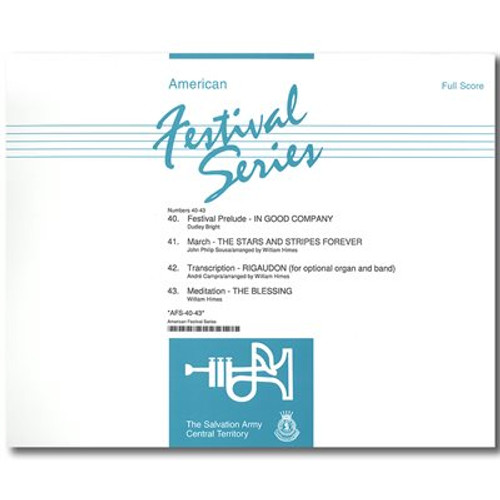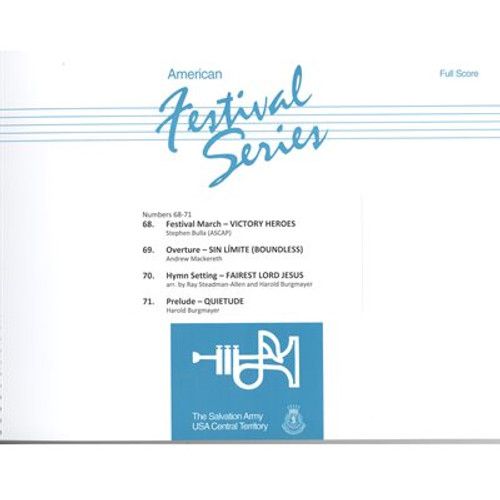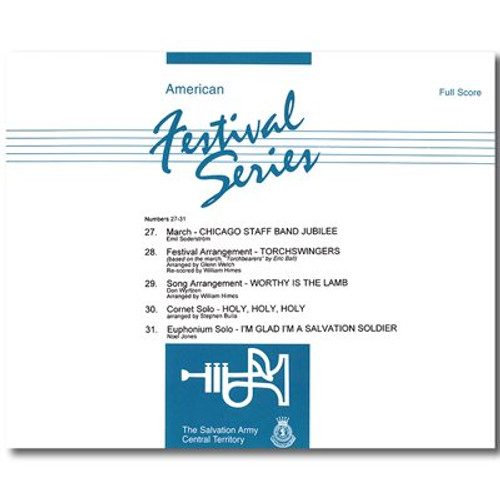Product Description
April 2018 Nos. 55-58
Brian Bowen, Editor
Dr. Harold Burgmayer, Music Secretary, USA Central Territory
We are pleased to present these four varied selections in Festival Series brass band format. The lively Festival March - Shout Aloud by Kevin Larsson and the vibrant song Arrangement - Raise the Song by Simon Morton contrast the moving Selection - Jehovah Rohi by William Himes, O.F.
Concluding this edition of the American Festival Series;Backorder=No is an exciting arrangement by Dr. Harold Burgmayer of the praise song, You Are Good by Israel Houghton, which is useful as a stand-alone piece or for congregational singing. Note that three of the four pieces utilize three percussion parts. All notes are written by the arrangers.
| 55. | Festival March - Shout Aloud! | Kevin Larsson | Notes |
| 56. | Selection - Jehovah Rohi | William Himes | Notes |
| 57. | Song Arrangement - Raise the Song | Simon Morton | Notes |
| 58. | Song Arrangement - You Are Good | Israel Houghton, arr. Harold Burgmayer | Notes |
Produced by The Salvation Army - Central Territory
55. Festival March - Shout Aloud!
Program Note:
This festival march is taken from a larger work written for the "North American Brass Celebration," which brought together all the Staff and Territorial Bands of North America to celebrate the Western Territory Staff Band's 10th year anniversary. While there are references to the classic festival march by Leslie Condon Celebration, the march uses as its principal theme an old Salvation Army tune, "Lift up the banner," with the following words:
This festival march is taken from a larger work written for the "North American Brass Celebration," which brought together all the Staff and Territorial Bands of North America to celebrate the Western Territory Staff Band's 10th year anniversary. While there are references to the classic festival march by Leslie Condon Celebration, the march uses as its principal theme an old Salvation Army tune, "Lift up the banner," with the following words:
- We'll shout aloud through the land
- The praises of our God,
- We'll fight beneath our flag unfurled,
- Kept by His precious blood.
- So we'll lift up the banner on high,
- The salvation banner of love;
- We'll fight beneath its colors till we die,
- Then go to our Home above.
Note to the conductor:
This march is "busy" with many musical lines that need to be brought out independently or sometimes in combination. While there are many opportunities for the band to open up dynamically, taking a lighter approach style-wise is advisable throughout.
Beginning to bar 15: The piece commences with a pick-up beat, then a bar of 6/8 (which should be beat in two), then a 2/4 bar, before proceeding forward in 4/4 time. Like much of this piece, observe the varying articulations and work for good dynamic contrast. The quotes from the march Celebration (bars 7-8) should be brought out.
Bars 16-36: Be sure the main theme in the flugel and horns sits in front of the lively "Hollywood-style" accompaniment. Work for uniform articulation particularly in bars 26-28. Trombones quote for the first time Lift High the Banner at bars 33-34, surrounded by a brazen Afro-Cuban accompaniment in percussion (using bongos, toms and maracas) with cornets, flugel, baritones and euphoniums. At bar 36, back-row cornets, flugel and solo horn conclude the section with flutter tonguing.
Bars 37-77: A complete presentation of the Lift High the Banner tune commences in the euphonium-baritones. The accompaniment, pitting the syncopated trombones against the tubas, needs to be secure, measured, and never heavy. The cornets need to use a wide range of dynamics with their entrances. The mellows take up the next phrase of the tune at bar 45 in a more traditional legato style. The cornets and trombones entry from bars 48-51 should rise gradually from piano to fortissimo. As this presentation of Lift High the Banner concludes, be sure the cornets and trombones observe the forte-mezzo piano to allow the flugel and horns to be heard at bars 55-56. In typical march fashion, a reprise of the opening theme commences at bar 59 concluding with a full fortissimo finish at bar 77.
Bars 78 to end: A transition section pits the cornets in canon with the baritones quoting Lift High the Banner against a tricky syncopated accompaniment in a long crescendo to fortissimo. Bring out the baritone answering figure so that it is heard. Commencing from bar 86, the original march melody (from bar 15) and the Lift High the Banner tune are combined. The concluding bars (from bar 102) require a scaled crescendo (once again from mezzo piano to fortissimo), as well as careful rhythmic articulation.
56. Selection - Jehovah Rohi
Program Note:
Jehovah Rohi is the opening phrase of Psalm 23 ("The Lord is my shepherd") and is one of many biblical names for God. In 1862, after preaching a sermon on this scripture, Joseph Gilmore was inspired to write his poem which began, "He leadeth me, O blessed thought!" Soon it was set to music by the great hymnodist, William Bradbury. But in addition to the original melody, this selection also features three contemporary tunes by Salvationists Thomas Mack, Paul Kellner and James Curnow. It concludes with Harold Brown's chorus, "Follow, I will follow thee my Lord" as a personal affirmation of God's continued guidance.
This was written to honor the ministry and leadership of Commissioners Barry and Sue Swanson, on the occasion of their retirement as leaders of the USA Eastern Territory.
Jehovah Rohi is the opening phrase of Psalm 23 ("The Lord is my shepherd") and is one of many biblical names for God. In 1862, after preaching a sermon on this scripture, Joseph Gilmore was inspired to write his poem which began, "He leadeth me, O blessed thought!" Soon it was set to music by the great hymnodist, William Bradbury. But in addition to the original melody, this selection also features three contemporary tunes by Salvationists Thomas Mack, Paul Kellner and James Curnow. It concludes with Harold Brown's chorus, "Follow, I will follow thee my Lord" as a personal affirmation of God's continued guidance.
This was written to honor the ministry and leadership of Commissioners Barry and Sue Swanson, on the occasion of their retirement as leaders of the USA Eastern Territory.
Note to the Conductor:
The content of this selection is a bit unique in that it features four contrasting tunes all associated with the same text, Joseph Henry Gilmore's enduring hymn, "He leadeth me." The concept of God as our personal shepherd connotes contrasting scenes of serenity and intensity ("o��er waters still, or troubled sea, my God still leadeth me.") Matters of style and interpretation are obvious and covered with specific directives.
Overall, the music calls for a flowing, legato style but here are a few specifics to consider along the way:
Introduction: The opening motif is used to link the piece from start to finish. (Actually, it is an inversion of the Curnow tune featured near the end.) You will want to be aware of this supportive underpinning throughout. This leads very naturally into the William Bradbury tune at bar 7.
Bars 31-34: Make the most of the rallentando to facilitate the sudden tempo change at 33 leading into the Thomas Mack tune. Although quicker (mm=92) the texture should be light and easygoing.
Bars 52-65: The trombone solo eventually mingles with an echo of the Bradbury melody in solo cornet, but the objective is for the trombone theme to be dominant.
Bars 68-83: Here Paul Kellner's tune, with its warm chromatic harmonies, provides perhaps the most intense moment of the piece.
Bars 92-107: This intimate setting of James Curnow's tune is actually a dialog between solo horn (melody) and euphonium with echoes of the link motif appearing at times in the trombone. Transparency and balance is the goal, always deferring to the melody.
Bars 108 to end The song's final chorus grows to a warm and expressive peak, followed by a sudden change of tempo and mood, concluding with Harold Brown's chorus of commitment:
- Follow, I will follow thee, my Lord,
- Follow every passing day.
- My tomorrows are all known to thee.
- Thou will lead me all the way.
57. Song Arrangement - Raise the Song
Program Note:
Raise the Song was written for the New York Staff Band and premiered at its 128th Annual Festival in New York City. The tune is most commonly associated with harvest time with the phrase "raise the song" coming form the second line of the first verse. Even thought the piece opens in a minor key, this piece is intended to be a celebratory statement, as the hard toil of gathering "crops," ultimately becomes and anthem of rejoicing and thanks!
Raise the Song was written for the New York Staff Band and premiered at its 128th Annual Festival in New York City. The tune is most commonly associated with harvest time with the phrase "raise the song" coming form the second line of the first verse. Even thought the piece opens in a minor key, this piece is intended to be a celebratory statement, as the hard toil of gathering "crops," ultimately becomes and anthem of rejoicing and thanks!
- Come, ye thankful people, come,
- Raise the song of harvest home;
- All is safely gathered in
- Ere the winter storms begin.
- God, our maker doth provide
- For our wants to be supplied;
- Come to God's own temple, come,
- Raise the song of harvest home.
Note to the Conductor:
Beginning to bar 27: Establish a brisk tempo from the start to set the pace for the rest of the piece. Well-articulated accents are needed starting at bar 5. The ostinato sixteenth notes at bar 15 should be played evenly at a controlled forte dynamic. At bar 17 and following, be sure that the solos between euphonium, Eb and Bb basses match in articulation and style.
Bars 28 to end: The bass ostinato should not overpower the melody presented in its entirety from bar 30. When approaching bar 46, allow the triplet figures to drive forward. The key change at bar 50 will lighten the mood a little, which the band should reflect in its playing. The chords at bar 67 should be well balanced and land precisely on the downbeat each time. No rallentando is necessary at the end and will bring the piece to a rousing conclusion.
Song Arrangement - You Are Good
Program Note:
An exciting setting of Israel Houghton's praise anthem, Lord, You Are Good.
An exciting setting of Israel Houghton's praise anthem, Lord, You Are Good.
Note to the Conductor:
This arrangement is useful as a congregational song accompaniment, based on Israel Houghton's vibrant anthem, Lord, You Are Good.
Beginning to bar 46: The rhythmic introduction sets the stage for the song's start at bar 5. Throughout the arrangement, rhythms have been "rounded," particularly using a dotted eighth and sixteenth, rather than a triplet, so that the rhythms should not sound like they are swung. Note the tenuto-accent articulation to be used on the dotted eighth and sixteenth combinations which surrounds the melody. At bar 18, be sure to drop the dynamic substantially, building to and explosive transition into the refrain at bar 22. Give plenty of opportunity for the baritones, euphoniums and basses to sound in that bar. The middle accompaniment in the horns and baritones from bar 22 is intended to emulate the strum of an electric guitar and this should work organically with the bass line.
Bar 47 to end: At bar 47, all are asked to sing the simple chorus, God is so Good, accompanied by a trombone trio. The conductor may want to turn and include the congregation on that refrain. The percussion transitions the band into the bridge section (bar 55), which builds by adding layers. At bar 79, a more thinly scored reprise of the chorus requires a lighter approach before the build-up from the repeat at the del segno (bar 86) and following. Work for a solid, but tight conclusion from bar 90 to the end.







